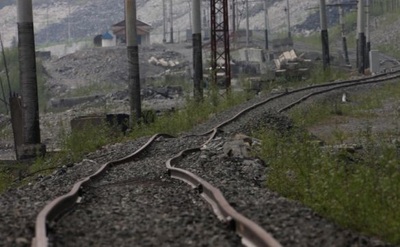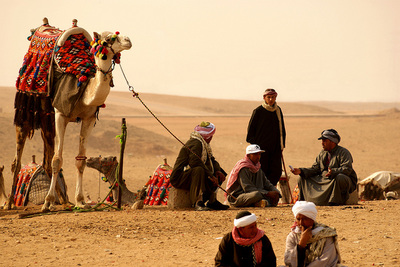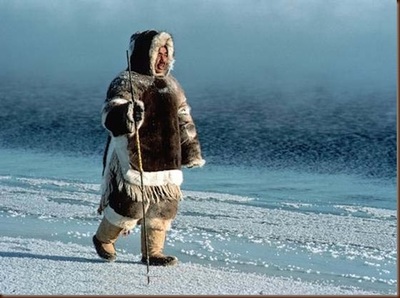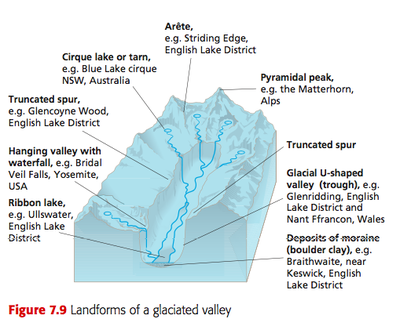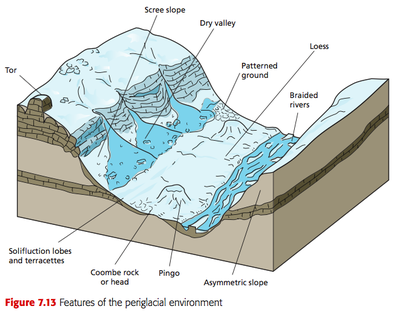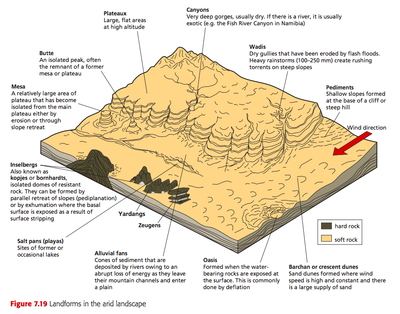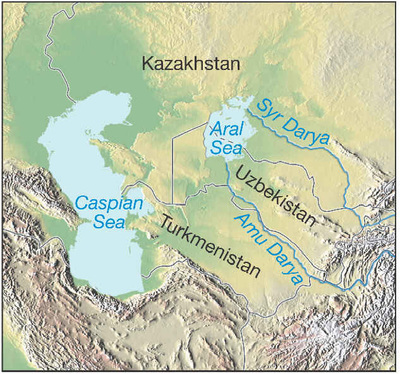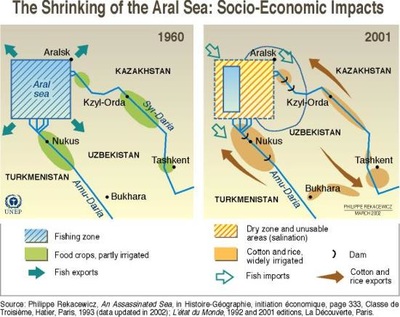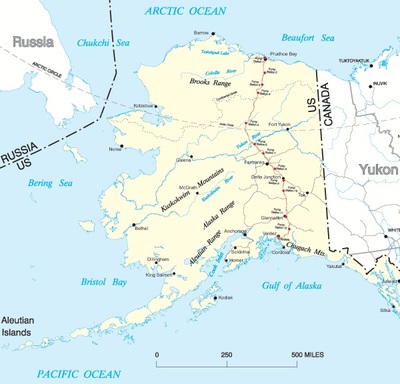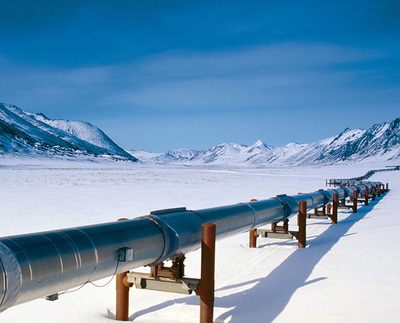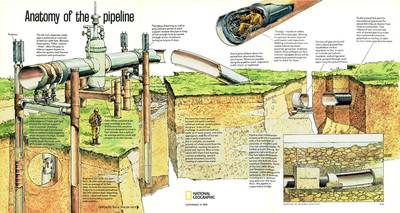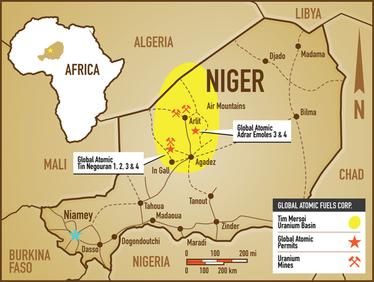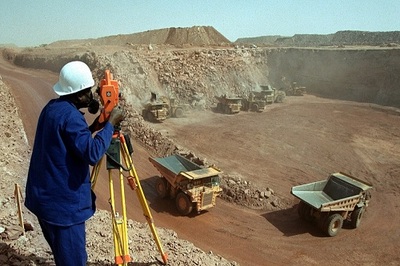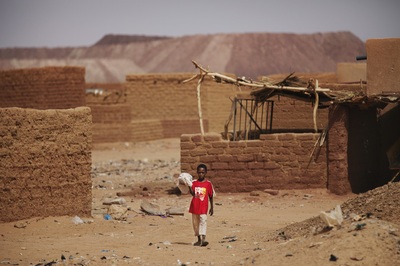1. Challenging environments
i. Explain the global distribution of each of the two kinds of extreme environment.
Arid environments are typically found around latitudes of 30° North and South of the Equator.
Polar environments and tundra are located in the Arctic circle and the coastline of the Antarctic continent.
However, high altitude extreme environments are spread throughout the globe wherever mountain ranges are found. In particular the Andes, Alps and Himalaya ranges.
Arid environments are typically found around latitudes of 30° North and South of the Equator.
Polar environments and tundra are located in the Arctic circle and the coastline of the Antarctic continent.
However, high altitude extreme environments are spread throughout the globe wherever mountain ranges are found. In particular the Andes, Alps and Himalaya ranges.
ii. Describe the relief and climatic characteristics that make these environments extreme.
Desert land forms are creates through wind and water erosional processes. Desert land forms may be formed by the deflation of surrounding softer rock material or the abrasive effects of sediment movement.
Glacial landforms are usually created by the powerful erosional effects of glacial movement and retreat.
iii. Explain how these characteristics present challenges for resource development and human habitation.
Extreme environments provide a range of challenges for humans.
Obvious challenges include the unavailability of water, food and fuel. Extreme environments are also inhospitable for human comfort.
However, secondary challenges include remoteness. In addition to the absence of people, infrastructure can be challenging to construct in remote locations. Roads and rail lines can buckle in the heat of deserts or through the melting and freezing of permafrost.
Desert land forms are creates through wind and water erosional processes. Desert land forms may be formed by the deflation of surrounding softer rock material or the abrasive effects of sediment movement.
Glacial landforms are usually created by the powerful erosional effects of glacial movement and retreat.
iii. Explain how these characteristics present challenges for resource development and human habitation.
Extreme environments provide a range of challenges for humans.
Obvious challenges include the unavailability of water, food and fuel. Extreme environments are also inhospitable for human comfort.
However, secondary challenges include remoteness. In addition to the absence of people, infrastructure can be challenging to construct in remote locations. Roads and rail lines can buckle in the heat of deserts or through the melting and freezing of permafrost.
iii. Explain the other factors responsible for a low density of population in these areas: human discomfort, inaccessibility, remoteness.
Humans have a relatively wide range of tolerance for temperatures. However, temperatures outside of -10°C and 35°C are intolerable in the long term.
Extreme environments are often far from human habitation. However, they are also made difficult to access because they are on difficult topography or unstable ground (such as summer tundra) make them inaccessible.
Humans have a relatively wide range of tolerance for temperatures. However, temperatures outside of -10°C and 35°C are intolerable in the long term.
Extreme environments are often far from human habitation. However, they are also made difficult to access because they are on difficult topography or unstable ground (such as summer tundra) make them inaccessible.
iv. Identify ways in which people adapt their activities to extremes of weather and climate.
People have been able to devise shelter and clothing that allows them to inhabit most of the world's surface.
People have been able to devise shelter and clothing that allows them to inhabit most of the world's surface.
2. The physical characteristics of extreme environments
i. Explain the advance and retreat of glaciers and the main features resulting from the processes of erosion and deposition by glaciers.
Glaciers are not stationary landforms, they are moving rivers of ice.
Glaciers are not stationary landforms, they are moving rivers of ice.
ii. Explain permafrost, patterned ground, solifluction, thermokarst, pingos.
iii. Explain weathering and the processes involved in wind- and water-formed features.
iv. Explain the occurrence of flash floods.
iv. Explain the occurrence of flash floods.
3. Opportunities and challenges for management
i. Hot, arid areas: examine the opportunities for agriculture in these areas, the distinction between aridity and infertility, the importance of irrigation and risk of salinisation, and the processes and factors involved in desertification.
Basically, arid soils lack moisture while infertile soils lack vital nutrition such as nitrogen, phosphorous and potassium. These problems often occur together and can be exacerbated by human activity. Arid and semi-arid areas have a negative water balance meaning that evapotranspiration and stores of water exceed the inputs of precipitation. Infertility is caused by low organic content and biomass decay, thin soils and therefore limited mineral content, and weak leaching leading to a bulid-up of salt from transpiration. However interference through population pressure, over cultivation, deforestation and overgrazing, soils become exposed to rainfall and soil erosion increases. These factors increase the fragility of soils and threaten agricultural practice in hot and arid environments.
The region around the Aral Sea is a good example of an arid area which is being dramatically changed by agriculture and irrigation.
Australia faces significant challenges to its agricultural industries due to increasing salinity. the ABC programme 7.30 report explored Australian salinity.
The Sahel region South of the Sahara desert is at high risk of desertification due to the combination of its aridity and poverty. Eden Foundation and Green Facts both describe the combination of human activity and drought that lead to desertification.
Basically, arid soils lack moisture while infertile soils lack vital nutrition such as nitrogen, phosphorous and potassium. These problems often occur together and can be exacerbated by human activity. Arid and semi-arid areas have a negative water balance meaning that evapotranspiration and stores of water exceed the inputs of precipitation. Infertility is caused by low organic content and biomass decay, thin soils and therefore limited mineral content, and weak leaching leading to a bulid-up of salt from transpiration. However interference through population pressure, over cultivation, deforestation and overgrazing, soils become exposed to rainfall and soil erosion increases. These factors increase the fragility of soils and threaten agricultural practice in hot and arid environments.
The region around the Aral Sea is a good example of an arid area which is being dramatically changed by agriculture and irrigation.
Australia faces significant challenges to its agricultural industries due to increasing salinity. the ABC programme 7.30 report explored Australian salinity.
The Sahel region South of the Sahara desert is at high risk of desertification due to the combination of its aridity and poverty. Eden Foundation and Green Facts both describe the combination of human activity and drought that lead to desertification.
Periglacial areas: examine the opportunities and challenges posed by permafrost and other characteristics of periglacial areas for resource development (mineral extraction and any associated settlement and communications).
The Trans Alaskan Pipeline System (TAPS) is an example of resource extraction from a glacial environment. The pipeline system has numerous design features included to protect it from the extreme environment in which it is located. However, the remoteness of the pipeline makes it vulnerable to sabotage and gunfire.
Although the construction of TAPS cost approximately US$8 billion it was a privately funded project. The record $900 million created by the Prudhoe Bay oil lease sale took place at a time when the entire state budget was less than $118 million, yet the entire amount created by the sale was used up by 1975.
Environmental, legal, and political debates followed the discovery of oil at Prudhoe Bay in 1968, and the pipeline was built only after the oil crisis provoked the passage of legislation designed to remove legal challenges to the project.
Although the construction of TAPS cost approximately US$8 billion it was a privately funded project. The record $900 million created by the Prudhoe Bay oil lease sale took place at a time when the entire state budget was less than $118 million, yet the entire amount created by the sale was used up by 1975.
Environmental, legal, and political debates followed the discovery of oil at Prudhoe Bay in 1968, and the pipeline was built only after the oil crisis provoked the passage of legislation designed to remove legal challenges to the project.
|
Hot, arid areas: examine the opportunities and challenges posed for resource development (mineral extraction and any associated settlement and communications).
In the hot arid environment of Niger Uranium mining forms a significant economic activity in an otherwise extremely poor society. Niger's Human Development Index is the lowest in the world at 0.348. Although mining brings funds into Niger, it has not lifted the country out of poverty. The poverty and hot arid environments combine to affect Niger's poorest most heavily. Workers are issued with little in the way of protective clothing for either heat or radioactivity. The activity of the mine also impacts on ground water. However, Niger's lack of development and stability also makes uranium mines vulnerable. In 2013, an Al Qaeda attack on a mine in Arlit raised concerns that mines could become a source of radioactive material for global terrorist activity. |
|
|
|
Examine the opportunities and challenges posed by the
development of tourism and any associated settlement and communications in one type of extreme environment. Around 31,000 people visited the Everest region in 2011. Most of these have traveled through Kathmandu and the villages between there and Mt Everest. The influx of tourists to the Himalayas to for trekking and climbing poses a significant challenge for the extreme environment found there. However, wealth and environmental awareness are also generated by tourism. |
Examine the impacts of tourism on the environment, such as mass movements and erosion, land degradation,
vulnerability to hazards, aesthetic change, water usage and waste disposal.
The Alpine environment of the Himalayas is very fragile due to cold temperatures and slow vegetation growth. This is further complicated by Nepal's poverty.
Resource use and waste disposal are significant challenges.
However the removal of vegetation to support the tourist industry encourages erosion.
vulnerability to hazards, aesthetic change, water usage and waste disposal.
The Alpine environment of the Himalayas is very fragile due to cold temperatures and slow vegetation growth. This is further complicated by Nepal's poverty.
Resource use and waste disposal are significant challenges.
However the removal of vegetation to support the tourist industry encourages erosion.
4. Sustainability
i. Discuss the degree to which human activities in extreme environments are unsustainable.
Extreme environments are fragile by their nature. Extreme environments are adapted to their harsh conditions through a range of adaptations that create very low productivity and resilience to change.
Humans have usually used these environments very lightly, either through very low population density, highly sensitive ecological management strategies or both.
As the world's population rises, not only are the direct pressures on extreme environments rising, the indirect pressures from climate change are also increasing. Furthermore, diminishing resources also drive humans to explore and extract resources in more remote locations that may have previously been cost prohibitive.
Extreme environments are fragile by their nature. Extreme environments are adapted to their harsh conditions through a range of adaptations that create very low productivity and resilience to change.
Humans have usually used these environments very lightly, either through very low population density, highly sensitive ecological management strategies or both.
As the world's population rises, not only are the direct pressures on extreme environments rising, the indirect pressures from climate change are also increasing. Furthermore, diminishing resources also drive humans to explore and extract resources in more remote locations that may have previously been cost prohibitive.
ii. Discuss the potential impact of global climatic change (global warming) on the indigenous populations, settlement and economic activities in extreme environments.
The extraction of oil from the Arctic and tourism in the Antarctic are both economic activities that are likely to be developed in the near future. Both these activities will have significant impacts on these extreme environments. The Inuit people's of Arctic Canada will experience an impact on their lifestyles as climates change.
Indigenous peoples have finely tuned cultural systems hallow them to mange scarce resources sustainability. These systems may not be able to accommodate changes in climate.
The extraction of oil from the Arctic and tourism in the Antarctic are both economic activities that are likely to be developed in the near future. Both these activities will have significant impacts on these extreme environments. The Inuit people's of Arctic Canada will experience an impact on their lifestyles as climates change.
Indigenous peoples have finely tuned cultural systems hallow them to mange scarce resources sustainability. These systems may not be able to accommodate changes in climate.
|
|
|

